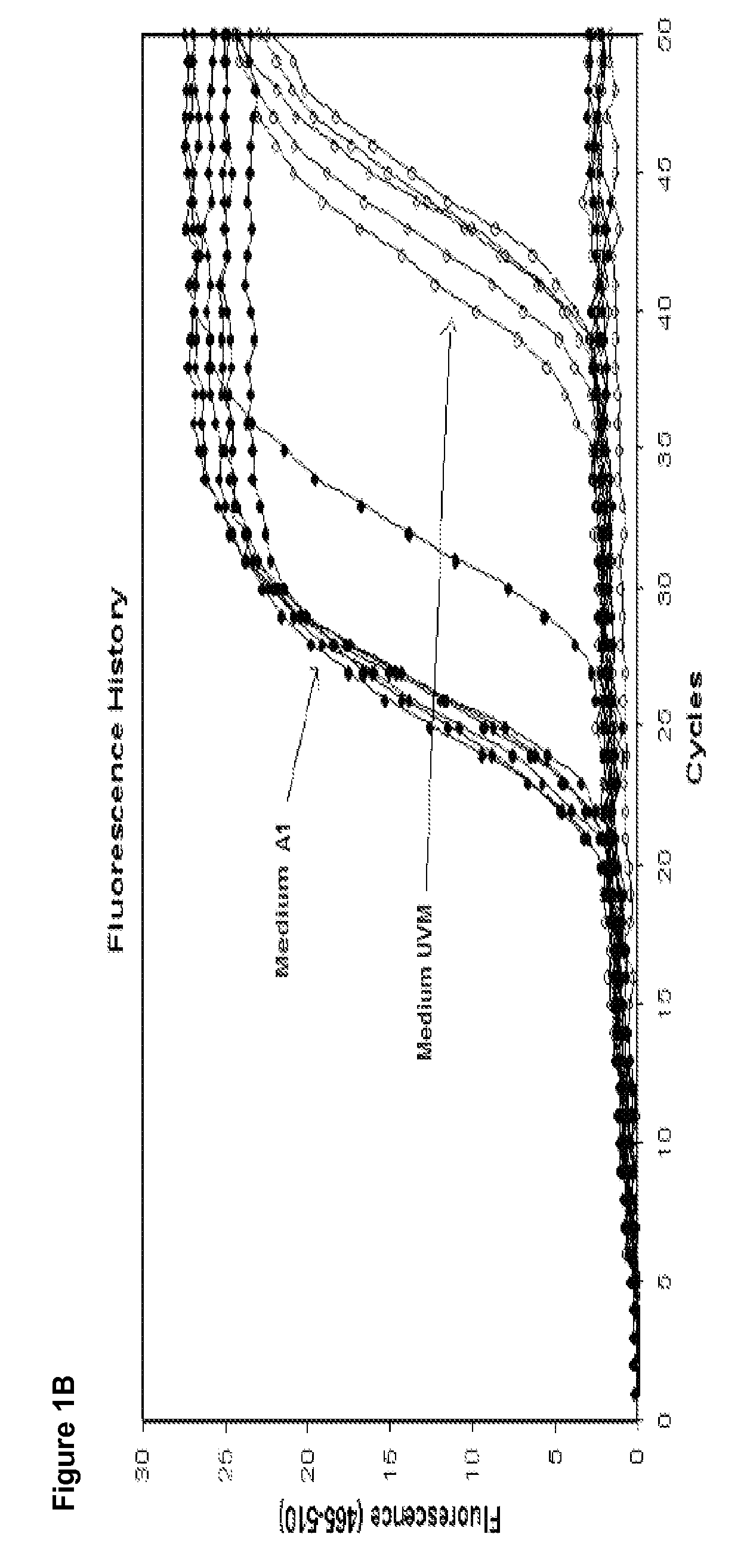Enrichment of Listeria spp
a listeria and enrichment technology, applied in the field of enrichment methods of listeria spp, can solve the problems of listeria /i>infection and consumption of contaminated foods, and achieve the effect of suppressing the growth of competing species and high growth ra
- Summary
- Abstract
- Description
- Claims
- Application Information
AI Technical Summary
Benefits of technology
Problems solved by technology
Method used
Image
Examples
example 1
Selection of Minimal Medium
[0055]A medium enhancing the growth of Listeria spp. during culture for 24 hours and which prevents or minimizes the inhibition of Listeria spp. detection caused by PCR was chosen.
[0056]Most commercially available Listeria spp.-enhancement media include high content of salt since Listeria have high osmolarity tolerance. For example, any salt selected from NaCl, and selection salt (LiCl) may be used in an amount of about 15 to about 20 g.
[0057]For comparison, Fraser broth (5 g of proteose peptone, 5 g of tryptone / casein dig., 5 g of beef extract (BE), 5 g of yeast extract (YE), 20 g of NaCl, 12 g of Na2HPO4.2H2O, 1.35 g of KH2PO4, 1 g of esculin, 0.5 g of iron (III) NH4 citrate, 3 g of LiCl, 0.024 g of acroflavine HCl, 0.02 g of nalidixic acid) was used, and PCR was conducted using the primers of SEQ ID NO: 5, 6, and the probe of SEQ ID NO: 7.
[0058]Culture was subjected to lysis and the lysate was subjected to PCR reaction. As a result, the Fraser broth com...
example 2
Selection of Medium
[0075]Individual ingredients of the Minimal Medium A1 selected in Example 1 that may have effects of enhancing the growth of Listeria spp. were identified and investigated.
[0076](1) Concentration of Lithium Chloride
[0077]By following the same procedure in Example 1 using Minimal Medium A1 as a base medium, LiCl was added to the basal medium to a concentration of 1, 3, 5, 7, 9 or 10 g / L. At the range between 7 and 10 g / L, the Cp values were very similar, indicating high LiCl concentration helped recovery of Listeria.
[0078]FIG. 2 is a graph of PCR results with the Minimal Medium A1, illustrating a change in cell concentration with respect to a concentration of LiCl in the Minimal Medium A1. Referring to FIG. 2, the higher the concentration of LiCl, for example in the range of 1-10 g / L, the smaller the Cp values and the more the cell growth was enhanced.
[0079](2) Culture of Listeria spp. in the Presence of Antibiotic
[0080]Sixty L. monocytogenes strains were cultured...
example 3
Recovery of Listeria spp. Collected from Stainless Steel Surface
[0088]Overnight-cultured L. welshimeri was diluted by 10-fold with 4% non-fat dry milk. 100 μL of the cell suspension was inoculated on a 1-in2 stainless steel surface and air-dried overnight. Next, cells were collected with a phosphate buffered saline (PBS)-soaked cotton swab, and cultured at 30° C. for 24 hours in the medium optimized A1 as shown above or a UVM-1 medium (Per 1 liter of water, 5 g of proteose peptone, 5 g of tryptone / casein dig., 5 g of beef extract (BE), 5 g of yeast extract (YE), 20 g of NaCl, 9.6 g of Na2HPO4.2H2O, 1.35 g of KH2PO4, 1 g of esculin, 0.012 g of acroflavine, and 0.02 g of nalidixic acid). The experiment was conducted at three contamination concentrations, i.e., about 1×102 cfu / in2, about 1×103 cfu / in2, and about 1×104 cfu / in2.
[0089]FIG. 5 is a graph illustrating the recovery of L. welshimeri, collected from a contaminated surface of stainless steel, in different media. In FIG. 5, the c...
PUM
| Property | Measurement | Unit |
|---|---|---|
| temperature | aaaaa | aaaaa |
| pH | aaaaa | aaaaa |
| temperature | aaaaa | aaaaa |
Abstract
Description
Claims
Application Information
 Login to View More
Login to View More - R&D Engineer
- R&D Manager
- IP Professional
- Industry Leading Data Capabilities
- Powerful AI technology
- Patent DNA Extraction
Browse by: Latest US Patents, China's latest patents, Technical Efficacy Thesaurus, Application Domain, Technology Topic, Popular Technical Reports.
© 2024 PatSnap. All rights reserved.Legal|Privacy policy|Modern Slavery Act Transparency Statement|Sitemap|About US| Contact US: help@patsnap.com










